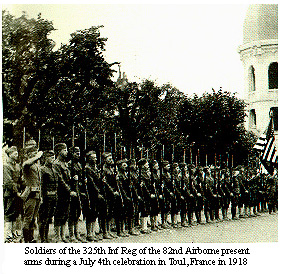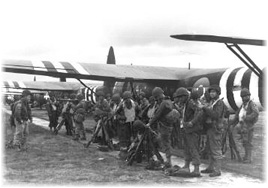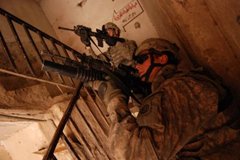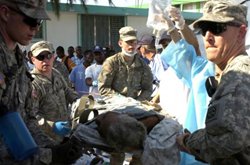|
WWI
 In April 1918, the Regiment received orders to move to Camp Upton, New York in preparation for embarkation to France. Their short stay at Camp Upton reflected a growing crisis in Europe. The German offensive in 1918 was a desperate attempt to win the war then and there. The Germans had made gains of over 45 miles in France. Other attacks along the Somme, Lys, and Assyne Rivers had stretched the British and French to their absolute limits. In April 1918, the Regiment received orders to move to Camp Upton, New York in preparation for embarkation to France. Their short stay at Camp Upton reflected a growing crisis in Europe. The German offensive in 1918 was a desperate attempt to win the war then and there. The Germans had made gains of over 45 miles in France. Other attacks along the Somme, Lys, and Assyne Rivers had stretched the British and French to their absolute limits.
Upon their arrival in Lettaure, France, the Regiment began the process of drawing their wartime equipment issued by the British. Steel helmets and gas masks were issued, as well as Lewis light machine guns, Vickers heavy machine guns and a full compliment of Stokes trench mortars and 37mm cannon. Finally, all of the soldiers had to turn in their rifles to receive the British Enfield rifles.
On June 16, 1918, the Regiment received orders to move to the Toul sector in France where they would enter the line as part of the 82nd Division under the control of the French VII Army. The British were not happy to see the Americans go. To reinforce this point, they took back all of the equipment they had issued. The Americans received back their "Eddystone" Enfield rifles. They were then moved by rail to central France and hurriedly issued French machine guns. These were the Hochkiss heavy machine gun and the Chauchat light machine gun, a weapon that held the distinction of being the absolute worst weapon of any type used by any side at any time during the war.
The Regiments first exposure to trenches came on June 18, 1918. They relieved elements of the U.S. 26th Division. 2d Battalion was positioned forward in what was known as the outpost line, 3d Battalion occupied the support line, and 1st Battalion was in reserve.
The Toul sector was a quiet one. It was for this reason that this sector was chosen to be the Regiment's first duty sector. The original intent while occupying the trenches was that units in the reserve position would conduct maneuver training and practice patrolling techniques. The French, however, decided that the trenches in the Toul Sector were inadequate and needed to be improved. Who better to undertake this task than the Americans in the reserve line.
The Regiment's time on the line came to an end on August 10, 1918.
They had spent less than two months in the sector learning what life in the trenches was really about. They were relieved by elements of the U.S. 89th Division.
After a brief rest, they moved to the Marabache sector to relieve elements of the 2nd U.S. Infantry Division who had been resting and refitting there. This sector was in the Moselle River Valley along the Selle River. Orders were to occupy the sector and conduct aggressive patrols throughout. One such patrol departed never to be seen again.
September was the month set for the first major American offensive of the war. It would also be the first offensive operation planned and designed by the American Army. The purpose of this operation was to reduce the St. Mihiel salient. It intended to accomplish a goal the French had not been able to accomplish for years.
St. Mihiel was a fortified town set on high ground overlooking the surrounding countryside. From it, German artillery could range the critical rail line that ran from Paris to positions along the front. The French had tried more than once to take St. Mihiel, but their attacks broke against fortified positions on the high ground.
The Regiment played a critical role in this operation. It was to secure the southern shoulder of the planned breach of the German lines, ensuring the Germans could not turn and cut off the attacking forces.
It was during this operation that the Regiment had its first encounter with the deadly mustard gas used by the Germans. They endured a night-long barrage of explosive and chemical artillery. When the sun rose the next morning the soldiers looked out onto a contaminated wasteland. Although the attack on St. Mihiel was unsuccessful, the 325th Regiment held its ground and accomplished its mission.
The American offensive in the Argonne Forest was the last major offensive of the war. It was designed to penetrate the German lines and disrupt their logistical base. This was preparatory to further offensive operations involving the actual invasion of Germany.
When the offensive opened on September 26, the Regiment received orders to remain prepared to move in two hours of notification. Day after day the men waited in the mud and cold waiting for the word to move. At 1800 on the 9th of October the Regiment finally received orders to move into position and attack to seize Cornay Ridge the next morning. The attack began precisely at 0700 the next morning. Meeting light resistance, the Regiment advanced virtually unopposed. One or two enemy machine guns were encountered as well as a few snipers. The attack on the Corny Ridge was an unexpected success and the ridge was captured by 0745 that morning.
New orders reached Colonel Whitman just after midnight. His orders were to cross the Aire river and mount a new attack. His 1st and 2nd Battalions were scattered all over the French countryside engaged in patrolling. Sending word to his 1st and 2nd Battalions to join him as soon as possible, Whitman, along with his 3d Battalion, crossed the Aire.
Through ten days of battle, the Regiment was able to punch a hole in the German's last line of defense. With their removal, Allied forces had a clear shot at continuing to advance into Germany. The Regiment had done the hard work and had lost 94 percent of its initial strength.
WWII
.jpg) After the war, the colors of the 325th Regiment were cased but were to be unveiled once again on March 25, 1942 under the command of Col. Claudius Easley. Located at Camp Claiborne, Louisiana, the Regiment was again to be part of the 82nd Division. Late in July 1943, the heavy equipment arrived that would turn the regiment into the 325th Motorized Infantry Regiment. After the war, the colors of the 325th Regiment were cased but were to be unveiled once again on March 25, 1942 under the command of Col. Claudius Easley. Located at Camp Claiborne, Louisiana, the Regiment was again to be part of the 82nd Division. Late in July 1943, the heavy equipment arrived that would turn the regiment into the 325th Motorized Infantry Regiment.
This suddenly changed when the Chief of Staff, General Marshall had decided that the 82nd Division would be an excellent division to use as a base for his proposed Airborne force. General Omar Bradley, because of his excellent work in training the 82nd Division, was to be transferred to the 28th Division which was having a great deal of trouble in meeting its training objectives. General Matthew Ridgeway, the 82nd Assistant Division Commander, would become its Commander.
The 325th Glider Infantry Regiment was formed and given the task of arriving into battle by glider. Parachutes could, and often did, wind up scattered for miles on a drop zone. The same held true for equipment and supplies. The glider was the answer to all these problems. As long as a glider stayed in one piece, the items inside it would too. This meant no more searching through the swamp looking for the missing barrel to a Howitzer. Jeeps could also fit into a glider. Best of all, troops could be put into a glider and land as a coherent fighting unit.
Gliderborne assaults, however, were not without their risks. Gliders and their tow planes were slow, fat targets. They had no armor to protect the men inside. Landing in a glider was also an adventure and little more than a controlled crash. Even if the pilot had the time and altitude to select a good spot to land, conditions on the ground of which he might be totally ignorant could wreck a landing. Ditches, wire, fences, tree stumps or a host of other possible ailments could flip, twist, or gut an unfortunate glider.
During the time of its introduction to the gliders, the Regiment lost its Commander. Col. Easley was promoted to Brigadier General and went to the 96th Division. He was replaced by Col. Harry Lewis who would guide the Regiment through its glider training and on to combat overseas. General and went to the 96th Division. He was replaced by Col. Harry Lewis who would guide the Regiment through its glider training and on to combat overseas.
The Regiment arrived to its first battle, not by air, but by sea. Boarding beach landing craft, the Regiment was sent to Salerno on the island of Sicily to reinforce American units already there. On September 15th at about 2300, they landed at Paestum, some eighteen miles south of Salerno where they awaited orders. Daybreak on the 16th brought orders. The 2nd Battalion was to re-board the landing craft and farther north to the town of Maiori. Here they were to be attached to Col. William O. Darby’s Ranger Task Force and relieve Ranger units currently holding positions on 4000 foot Mount St. Angelo di Cava. The Battalion was welcomed the next morning by a German artillery barrage. The Germans probed the Battalion lines. Despite numerous attempts to throw the Glidermen off the mountain, the Americans held their ground. It was here that the Regiment received its first casualties of the war.
On 7 June 1944, D-Day plus one, the Regiment landed by glider in Normandy and participated in the invasion of France. On 9 June, Private First Class Charles N. Deglopper single-handedly defended his platoon's position and subsequently was awarded the Medal of Honor for this action. As soldiers of the 325th Glider Infantry Regiment swooped down to Normandy, other elements of the 82nd Airborne Division were in the process of capturing the town of St. Mere Eglise on an airborne  operation behind enemy lines. It was for the success of their effort that the soldiers of the 82nd Airborne Division were awarded the red and green braided French Fourregerre. operation behind enemy lines. It was for the success of their effort that the soldiers of the 82nd Airborne Division were awarded the red and green braided French Fourregerre.
The next glider assault for the 325th was during Operation Market Garden, the largest airborne operation ever conducted. During this battle, the 325th landed among German positions that had surrounded other elements of the 82nd Airborne Division. This glider attack turned the tide of battle and earned the Regiment it’s first Distinguished Unit Citation.
The 325th saw more combat in December 1944 when it decimated two German Divisions during the Battle of the Bulge. In 1945, the 325th’s action in Germany ended with the Regiment driving deep into the heart of Germany. After the war, the Regiment assisted in Berlin occupational duties until it returned to the United States in 1946 and was deactivated on December 15, 1947.
The Regiment returned to the All American Division on December 15, 1948 and was redesignated this time the 325th Airborne Infantry Regiment.
Cold War
On May 1, 1965, the 325th deployed to the revolution-torn Dominican Republic as part of Operation Power Pack. Sent with the mission of relieving marines and evacuating civilians, the Regiment swept from the airfield at San Isidro into the capital city of Santo Domingo, neutralizing communist-backed rebel forces. By the end of May, all resistance had crumbled and the Regiment began peace keeping and Civil Affairs operations.
On 26 October 1983, as part of Operation Urgent Fury, the 325th Regiment spearheaded the All American Division’s assault on the communist dominated island of Grenada. Landing at Point Salines Airfield, the 2nd and 3rd Battalions in conjunction with other U.S. Forces overwhelmed all resistance within three days. One hundred thirty eight students were rescued.
During this operation, Bravo Company, Second Battalion was given the mission to assault an area known as Little Havanna. The Commander of Bravo Company, Captain Michael Ritz, decided to conduct a recon prior to the assault. At 0430 on 26 October, Captain Ritz and his recon patrol were ambushed. Captain Ritz was killed but the rest of his patrol, although wounded, survived.
Bravo Company soon discovered large caches of weapons and equipment. Staff Sergeant Gary Epps, a squad leader, found a loaded recoilless rifle and decided for the sake of safety to remove the round.. The round exploded as he was removing it and he was killed in the explosion.
In December 1989, the 4th Battalion "Gold Falcons" attached to the 1st Brigade, conducted a night parachute assault onto Torrijos International Airport in the Republic of Panama, during Operation Just Cause. The Gold Falcons’ assault on critical objectives assisted U.S. Forces in reestablishing the legitimate democratic government in Panama.
This operation represented the first combat parachute assault since World War II. The Battalion was to jump, assemble, and perform a helicopter assault to Fort Cimmarron to secure the garrison.
While this was taking place, Delta Company was tasked to stay behind and secure another airport within Panama City. It was during this operation on 21 December when Private James A. Taber Jr. was struck by a sniper's bullet and killed.
Gulf War
In August 1990, the 325th was called on to spearhead the deployment of U.S. Forces to the Persian Gulf in response to the Iraqi Invasion of Kuwait.
In a speech on August 8, President George H.W. Bush told the nation, "A Line in the Sand has been drawn," and the first U.S. Forces were being deployed to the Middle East. Those initial Forces were the 82nd Airborne Division’s Ready Brigade, the 325th Airborne Infantry Regiment. Their mission was to secure Dahran International Airport and the Port of Al Jubayl, Saudi Arabia for the buildup of U.S. Forces that would follow. While reinforcements streamed into the country, the 325th along with the remainder of the 82nd Airborne Division conducted the most intensive combat trainup in the unit’s history.
In mid-January, after the Air War had begun, the 82nd Airborne Division displaced nearly 650 miles to the northwest near the Iraqi border in preparation for the commencement of the ground war.
On February 22, elements of the Division along with soldiers of the 6th French Light Armored Division began their drive into Iraq. Division soldiers were responsible for the capture of several thousand Iraqi soldiers and the destruction of massive amounts of enemy weapons, equipment, and ammunition. The Division is credited with playing a major role in the highly successful 100 hour ground war.
The first Division elements began redeploying to Fort Bragg on March 7, and by early April the redeployment of the Division was complete.
Peacekeeping Operations
In September 1994, coinciding with the 50th anniversary of Operation MARKET-GARDEN, the 82nd again answered the nation's call and prepared to conduct a parachute assault in the Caribbean nation of Haiti to help restore democracy. With the troopers aboard aircraft heading towards the island, the defacto regime capitulated, and the Division was turned back to Fort Bragg.
82nd Airborne Division paratroopers were among the first ground troops sent into the war-torn Kosovo region of the Balkans in Summer 1999 to help put an end to ethnic cleansing and sectarian strife. The 1st Battalion, 325th Airborne Infantry Regiment in January deployed in 2001 as part of regular peacekeeping operation rotations.
Global War on Terrorism
When America was attacked on Sept. 11, 2001, President George W. Bush called upon the American military to fight global terrorism. 82nd soldiers were among the first to deploy to Afghanistan in support of Operation Enduring Freedom.
On March 28, 2003, the Regiment was again called on to spearhead the Division’s assault into Iraq in support of Operation Iraqi Freedom. During the initial invasion, the Regiment was ordered to attack into the town of As Samawah to seize four critical bridges over the Euphrates River. Paratroopers from the 325th AIR distinguished themselves with extraordinary heroism and gallantry during this action, and the Regiment was later awarded the Presidential Unit Citation. The Regiment later fought at Ad Diwaniyah, Ar Ramadi, and Baghdad. After the Iraqi Army capitulated in May 2003, the 325th AIR remained in Baghdad to conduct combat and support and stability operations. Missions continued until February 2004, when, after almost a year of sustained combat operations, the Regiment returned home to Fort Bragg.
In December 2004, the 2nd and 3rd Battalions of the 325th deployed to Iraq to provide a safe and secure environment for the country’s first-ever free national elections. Thanks in part to the efforts of 2nd Brigade paratroopers, more than eight million Iraqis were able to cast their first meaningful ballots.
In July of 2005, the Red Falcons of 1st Battalion deployed to Afghanistan in support of the Afghanistan national parliamentary elections. Faced with securing an area the size of Vermont, the Red Falcons’ dedication and relentless pursuit of the Taliban insurgents allowed violence-free elections to take place.
In September 2005, only six months after the end of their last deployment to OIF, the 2nd Battalion White Falcons returned to Iraq once more to provide contingency support in Tal’ Afar during the Iraqi National Elections. Their successes during the five-month deployment were commended by the President and recognized widely by the national media.
In January of 2006, the 325th AIR underwent one of the most momentous restructurings in its history. As part of the army-wide transformation program, the Regiment was reorganized into a modular structure to become the 2nd Brigade Combat Team. As part of the restructuring, the Brigade lost one infantry battalion – the 3-325 – while gaining an artillery battalion, a mounted reconnaissance and surveillance squadron, a support battalion, and a special troops battalion containing signal, MI, MP, and engineer companies.
 In January of 2007, the Falcons were given another critically important mission: to spearhead the “Surge” of U.S. Forces into Iraq to restore security to the capital of Baghdad. In January of 2007, the Falcons were given another critically important mission: to spearhead the “Surge” of U.S. Forces into Iraq to restore security to the capital of Baghdad.
With violence in Iraq escalating out of control, the President on January 10 announced a new strategy for victory involving an increase of forces and a new emphasis on counter-insurgency tactics. The unit he turned to first to execute the strategy was the 2nd BCT. Within a week of receiving orders, the Brigade had 3,000 troops, 300 vehicles, and thousands of pieces of equipment on the way to Iraq.
Over the next 15 months, the Falcon Paratroopers moved into small outposts throughout the city and waged an aggressive campaign against Al Qaeda terrorists, Sunni insurgents, Shiite militias, and other elements committed to destroying the fragile Iraqi democracy. At the same time, they devoted thousands of hours of labor and millions of dollars to rebuilding and infrastructure projects.
By Christmas of 2007, violence in the Falcon AO had declined by 95%, and violence throughout all of Iraq was down steeply. The Falcons had helped the Surge succeed beyond even the most optimistic expectations. The Regiment redeployed to Fort Bragg in March of 2008, to a well-deserved hero’s welcome.
In 2009, the 2nd BCT assumed the mantle of the GRF – the Global Response Force. Just as they have for the past 90 years, the paratroopers of the 2nd BCT, 325th AIR will be ready to answer the nation’s call anytime, anyplace.
On January 12th, 2010, a massive earthquake devastated the country of Haiti. The damage from the earthquake killed in excess of 200 thousand people and left over 2 million Haitian citizens without a home. The 2nd Brigade Combat team was alerted on 13 January and was able to deploy forces to Haiti later that day.
Within two weeks, the BCT completed its deployment to Haiti and provided desperately needed humanitarian assistance and disaster relief. While working closely with United Nations forces, the United States Agency for International Development and numerous non-governmental organizations the Falcons countered the humanitarian crisis by providing food, water, medical assistance and treatment, as well as shelter.
The compassion, skill, and dedication the Falcons demonstrated in Haiti allowed the government of Haiti, the United nations, USAID, and various non-governmental organizations to continue the long-term relief and rebuilding effort and the Falcon’s redeployed to Fort Bragg in March 2010.
Immediately following their redeployment from Haiti, the Brigade reassumed the GRF mission in April 2010 when the Red Falcons were immediately called to deploy to Operation Enduring Freedom in Afghanistan. During this short notice deployment, the Battalion served as trainers for the Afghan National Security Forces and operated in more than 17 different locations across the country, training units and Soldiers in the Afghan Army on basic skills and preparing them to defend their country. The Battalion, during their three month deployment, was able to train hundreds of Afghan Soldiers.
During the Red Falcon’s deployment, the BCT remained assigned as the Army component to the GRF, with augmentation from the 2nd Battalion, 505th Parachute Infantry Regiment, “2 Panther,” to ensure that the GRF was fully prepared to meet any contingency.
The BCT continues to stand ready to deploy anywhere in the world in support of our nation’s objectives.
|